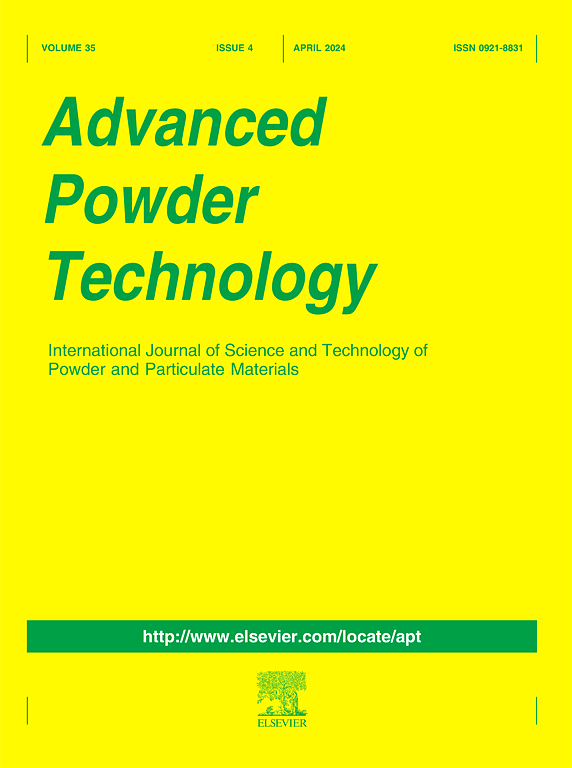Superquadric DEM study of the particle separation process in a multi-deck banana vibrating screen
IF 4.2
2区 工程技术
Q2 ENGINEERING, CHEMICAL
引用次数: 0
Abstract
Efficient separation of non-spherical particles is necessary for various chemical engineering processes, including screening in recycling industries. Discrete element method (DEM) has become a widely used tool for designing screening processes. This study uses a superquadric DEM model to design a 5-panel multi-deck banana screen for the separation of a specific particle mixture, with varying densities, sizes, and especially shapes, including rod-shaped, chip-shaped, and spherical. Then the effects of vibration conditions (frequency, amplitude, angle), design parameters (inclination angle, panel numbers), and feed particle numbers on the key parameters, including separation efficiency and particle penetration rates, are quantified. The simulation results indicate that under the investigated conditions, the highest separation efficiencies are found at 2 mm amplitude, 20 Hz frequency, and 45° vibration angle, yielding efficiencies of 90.8 % for rod-shaped particles, 71.0 % for chip-shaped particles, and 46.5 % for spherical residues. Higher frequencies generally improve rod-shaped and chip-shaped particles separation but lead to fluctuations for the spherical fines. Final particle penetration rates increase with frequency but decrease at higher amplitudes for low to moderate frequencies. This work may serve as a theoretical reference for separation process optimisation in similarly configured screening systems.

多层香蕉振动筛颗粒分离过程的超二次数值模拟研究
非球形颗粒的有效分离是各种化学工程过程所必需的,包括回收工业的筛选。离散元法(DEM)已成为筛选过程设计中广泛使用的工具。本研究使用超二次DEM模型设计了一个5面板多层香蕉筛,用于分离特定的颗粒混合物,这些颗粒混合物具有不同的密度,大小,特别是形状,包括棒状,片状和球形。然后,量化振动条件(频率、振幅、角度)、设计参数(倾角、面板数)和进料颗粒数对分离效率和颗粒穿透率等关键参数的影响。仿真结果表明,在2 mm振幅、20 Hz频率和45°振动角条件下,颗粒分离效率最高,棒状颗粒分离效率为90.8%,片状颗粒分离效率为71.0%,球形颗粒分离效率为46.5%。较高的频率通常会改善棒状和片状颗粒的分离,但会导致球形颗粒的波动。最终粒子穿透率随频率增加而增加,但在低至中等频率时,在较高的振幅下下降。这项工作可以作为在类似配置筛选系统分离过程优化的理论参考。
本文章由计算机程序翻译,如有差异,请以英文原文为准。
求助全文
约1分钟内获得全文
求助全文
来源期刊

Advanced Powder Technology
工程技术-工程:化工
CiteScore
9.50
自引率
7.70%
发文量
424
审稿时长
55 days
期刊介绍:
The aim of Advanced Powder Technology is to meet the demand for an international journal that integrates all aspects of science and technology research on powder and particulate materials. The journal fulfills this purpose by publishing original research papers, rapid communications, reviews, and translated articles by prominent researchers worldwide.
The editorial work of Advanced Powder Technology, which was founded as the International Journal of the Society of Powder Technology, Japan, is now shared by distinguished board members, who operate in a unique framework designed to respond to the increasing global demand for articles on not only powder and particles, but also on various materials produced from them.
Advanced Powder Technology covers various areas, but a discussion of powder and particles is required in articles. Topics include: Production of powder and particulate materials in gases and liquids(nanoparticles, fine ceramics, pharmaceuticals, novel functional materials, etc.); Aerosol and colloidal processing; Powder and particle characterization; Dynamics and phenomena; Calculation and simulation (CFD, DEM, Monte Carlo method, population balance, etc.); Measurement and control of powder processes; Particle modification; Comminution; Powder handling and operations (storage, transport, granulation, separation, fluidization, etc.)
 求助内容:
求助内容: 应助结果提醒方式:
应助结果提醒方式:


